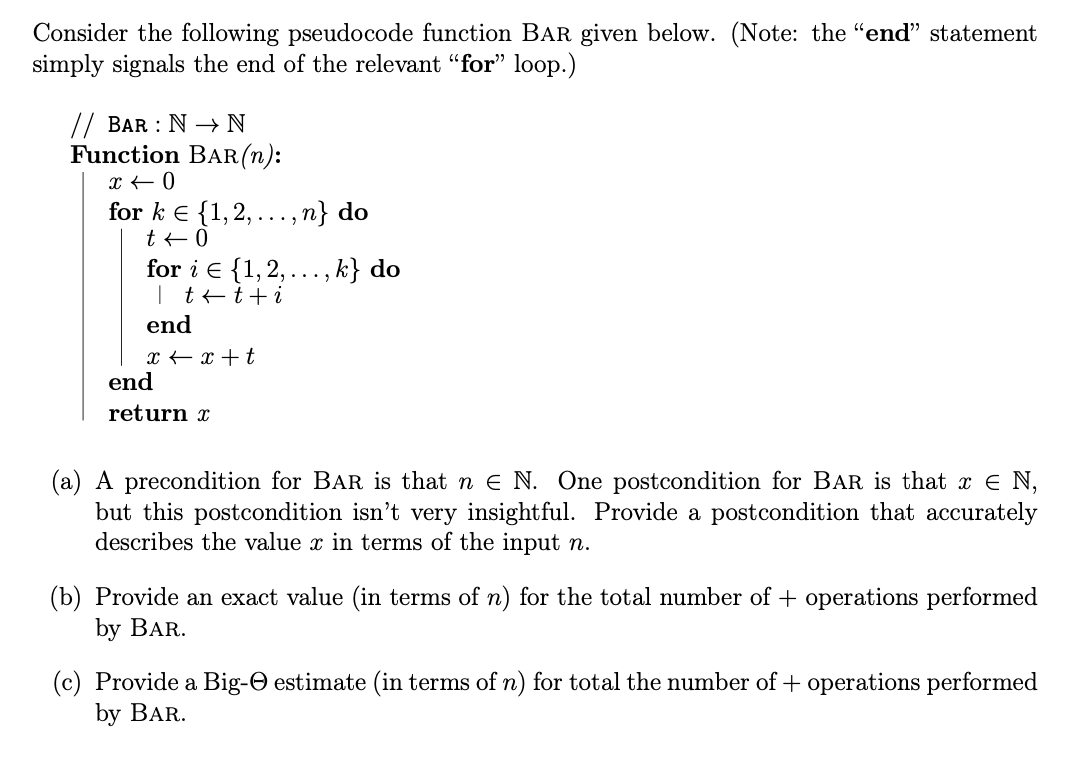Consider the following pseudocode function BAR given below. (Note: the "end" statement simply signals the end of the relevant "for" loop.) // BAR : N → N Function BAR(n): x 0 for k = {1, 2,...,n} do t←0 for i = {1, 2,..., k} do It+t+i end xx+t end return x (a) A precondition for BAR is that ne N. One postcondition for BAR is that x = N, but this postcondition isn't very insightful. Provide a postcondition that accurately describes the value x in terms of the input n. (b) Provide an exact value (in terms of n) for the total number of + operations performed by BAR. (c) Provide a Big-O estimate (in terms of n) for total the number of + operations performed by BAR.
Consider the following pseudocode function BAR given below. (Note: the "end" statement simply signals the end of the relevant "for" loop.) // BAR : N → N Function BAR(n): x 0 for k = {1, 2,...,n} do t←0 for i = {1, 2,..., k} do It+t+i end xx+t end return x (a) A precondition for BAR is that ne N. One postcondition for BAR is that x = N, but this postcondition isn't very insightful. Provide a postcondition that accurately describes the value x in terms of the input n. (b) Provide an exact value (in terms of n) for the total number of + operations performed by BAR. (c) Provide a Big-O estimate (in terms of n) for total the number of + operations performed by BAR.
C++ for Engineers and Scientists
4th Edition
ISBN:9781133187844
Author:Bronson, Gary J.
Publisher:Bronson, Gary J.
Chapter5: Repetition Statements
Section5.5: A Closer Look: Loop Programming Techniques
Problem 12E: (Program) Write a program that tests the effectiveness of the rand() library function. Start by...
Related questions
Question

Transcribed Image Text:Consider the following pseudocode function BAR given below. (Note: the "end" statement
simply signals the end of the relevant "for" loop.)
// BAR : N → N
Function BAR (n):
x < 0
for k = {1, 2,...,n} do
t + 0
for i = {1, 2,.
| t t + i
end
x + x + t
end
return x
., k} do
(a) A precondition for BAR is that ne N. One postcondition for BAR is that x = N,
but this postcondition isn't very insightful. Provide a postcondition that accurately
describes the value x in terms of the input n.
(b) Provide an exact value (in terms of n) for the total number of + operations performed
by BAR.
(c) Provide a Big- estimate (in terms of n) for total the number of + operations performed
by BAR.
Expert Solution
This question has been solved!
Explore an expertly crafted, step-by-step solution for a thorough understanding of key concepts.
This is a popular solution!
Trending now
This is a popular solution!
Step by step
Solved in 4 steps

Knowledge Booster
Learn more about
Need a deep-dive on the concept behind this application? Look no further. Learn more about this topic, computer-science and related others by exploring similar questions and additional content below.Recommended textbooks for you

C++ for Engineers and Scientists
Computer Science
ISBN:
9781133187844
Author:
Bronson, Gary J.
Publisher:
Course Technology Ptr

C++ for Engineers and Scientists
Computer Science
ISBN:
9781133187844
Author:
Bronson, Gary J.
Publisher:
Course Technology Ptr